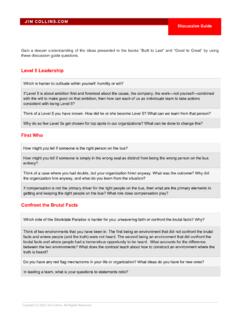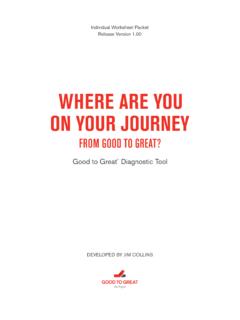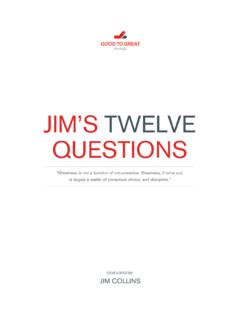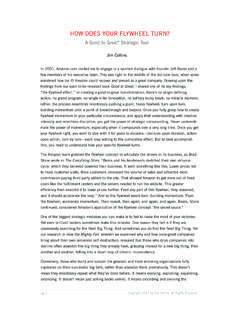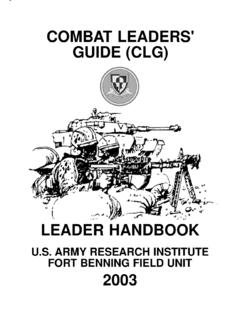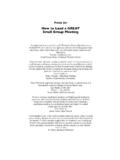Transcription of Where are you on your journey from Good to Great
1 PAGE 1 GOOD TO Great diagnostic tool . DEVELOPED BY JIM COLLINS. RELEASE VERSION 2006 BY JIM COLLINS. ALL RIGHTS are you on your journey from Good to Great ?Good to Great Diagnostic ToolDeveloped by Jim CollinsIndividual Worksheet PacketRelease Version 2 GOOD TO Great diagnostic tool . DEVELOPED BY JIM COLLINS. RELEASE VERSION 2006 BY JIM COLLINS. ALL RIGHTS OF USE FOR GOOD TO Great DIAGNOSTIC TOOLC onsent to TermsYour use of the Good to Great diagnostic tool (the diagnostic tool ) is subject to these Terms of Use ( Terms ). Please read them carefully.
2 By using the diagnostic tool , you agree to be bound by these Terms. If you do not agree with, or cannot abide by these Terms, please do not make any use of the diagnostic tool . These Terms may be modified at any time at our discretion by posting the modified Terms on the Jim Collins web site. Use after posting will constitute your agreement to abide by the modified content of the diagnostic tool is protected by and international copyright laws. You may use, reproduce, distribute, transmit, or display any copyrighted material only within the Terms.
3 Derivative works may not be made. You may download, print and copy the diagnostic tool for your personal (including intra-company), non-commercial use only, provided that you include all copyright and other notices contained in the diagnostic tool and that you do not modify the diagnostic tool . Any other use of the diagnostic tool is expressly prohibited. DISCLAIMERTHE diagnostic tool IS PROVIDED ON AN AS IS AND AS AVAILABLE BASIS, WITHOUT ANY WARRANTIES OF ANY KIND, EITHER EXPRESS OR IMPLIED, INCLUDING WARRANTIES OF TITLE OR IMPLIED WARRANTIES OF MERCHANTABILITY OR FITNESS FOR A PARTICULAR PURPOSE.
4 NO WARRANTIES ARE MADE REGARDING ANY RESULTS THAT MAY BE OBTAINED FROM USE OF THE diagnostic tool . LIMITATION OF LIABILITYIN NO EVENT WILL JIM COLLINS, HIS OFFICERS, EMPLOYEES OR AGENTS BE LIABLE FOR ANY INDIRECT, CONSEQUENTIAL, SPECIAL, INCIDENTAL OR PUNITIVE DAMAGES, ARISING OUT OF THE USE OR INABILITY TO USE THE diagnostic tool OR ANY RESULTS OBTAINED FROM USE OF THE diagnostic tool . IN NO EVENT WILL JIM COLLINS, HIS OFFICERS, EMPLOYEES OR AGENTS BE LIABLE FOR ANY AMOUNT IN EXCESS OF $ Terms represent the entire understanding of the parties regarding the use of the diagnostic tool and supersede any previous documents, correspondence, conversations, or other oral or written understanding related to these Terms of Use.
5 These Terms shall be governed by and construed under the laws of the State of Colorado without regard to its choice of law, rules, and, Where applicable, the laws of the United States. To the extent permissible by law, any disputes under these Terms of Use or relating to the diagnostic tool shall be litigated in the District Court in and for the District of Colorado, and you hereby consent to personal jurisdiction and venue in the District of Colorado. A modification or waiver of a part of these Terms of Use shall not constitute a waiver or modification of any other portion of the Terms of Use.
6 If for any reason any provision of these Terms of Use is found unenforceable, that provision will be enforced to the maximum extent permissible, and the remainder of the Terms of Use will continue in full force and 3 GOOD TO Great diagnostic tool . DEVELOPED BY JIM COLLINS. RELEASE VERSION 2006 BY JIM COLLINS. ALL RIGHTS OF THE GOOD TO Great FRAMEWORKA Great organization is one that makes a distinctive impact and delivers superior performance over a long period of time. For a business, performance principally means financial results, specifically return on invested capital.
7 For a social sector organization, on the other hand, performance must be assessed first and foremost relative to the organization s mission, not its financial results. Notice that by this definition that you do not need to be big to be Great . Your distinctive impact can be on a local or small community, and your performance can be superior and long-lasting without becoming large. You might choose to grow in order to have a wider impact and to better deliver on your mission, but it is important to understand that big does not equal Great , and Great does not equal derived these principles from a matched-pair research method, wherein we systematically analyzed companies that at-tained greatness during a particular phase of their histories in contrast to carefully selected comparison companies com-panies facing nearly identical circumstances that failed to attain greatness during the exact same historical eras.
8 The Good-to- Great Matched Pair Research MethodInflection PointGood, not GreatGood, not GreatMatched-pair Selection(Comparable cases at the moment of inflection)What principles explain the difference?Comparison CasesGood-to- Great CasesPAGE 4 GOOD TO Great diagnostic tool . DEVELOPED BY JIM COLLINS. RELEASE VERSION 2006 BY JIM COLLINS. ALL RIGHTS 5 LEADERSHIPTHE GOOD TO Great FRAMEWORKThe key is to recognize that the good-to- Great principles are not a definition of greatness, but rather they represent a series of principles for how to achieve greatness; they are input variables, not output variables.
9 The first step in your never-ending journey from good to Great is to be clear on the two sides of the diagram below, rigorously implementing the left side of the page and rigorously assessing your results on the right side of the page. INPUT PRINCIPLES*Stage 1: DISCIPLINED PEOPLEL evel 5 LeadershipFirst Who, Then WhatStage 2: DISCIPLINED THOUGHTC onfront the Brutal FactsThe Hedgehog ConceptStage 3: DISCIPLINED ACTIONC ulture of DisciplineThe FlywheelStage 4: BUILDING GREATNESS TO LAST**Clock Building, not Time TellingPreserve the Core/Stimulate ProgressBY APPLYING THE GOOD TO Great FRAMEWORK YOU BUILD THE FOUNDATIONS OF A Great ORGANIZATION* See a summary of the concept definitions on the next page for a brief definition of each concept.
10 ** The principles in Stages 1-3 derive from research for the book Good to Great by Jim Collins; the principles in Stage 4 derive from the book Built to Last by Jim Collins and Jerry I. Porras. OUTPUT RESULTSD elivers Superior Performancerelative to its missionMakes a Distinctive Impacton the communities it touchesAchieves Lasting Endurancebeyond any leader, idea or setbackPAGE 5 GOOD TO Great diagnostic tool . DEVELOPED BY JIM COLLINS. RELEASE VERSION 2006 BY JIM COLLINS. ALL RIGHTS TO Great CONCEPT SUMMARYOur research shows that building a Great organization proceeds in four basic stages; each stage consists of two fundamental principles: STAGE 1: DISCIPLINED PEOPLEL evel 5 Leadership.
